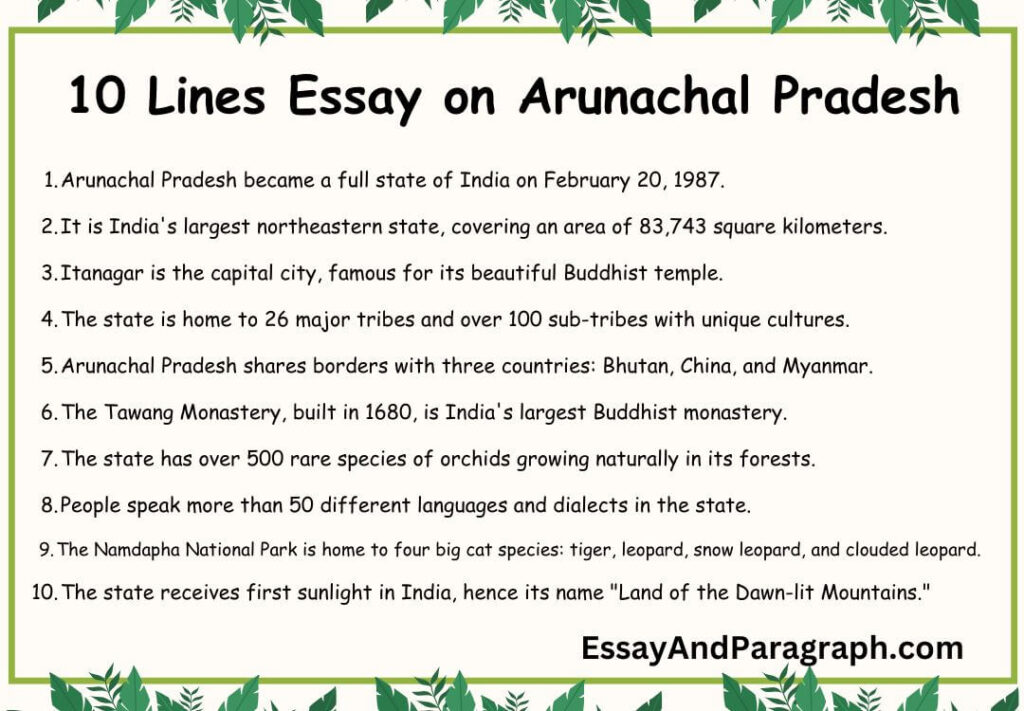Have you ever wondered where in India the sun first rises each morning? Welcome to Arunachal Pradesh, the “Land of the Dawn-lit Mountains,” where India’s day begins! This enchanting northeastern state, nestled in the eastern Himalayas, is a treasure trove of natural wonders, diverse tribes, and colorful traditions. Let’s explore this magical land where ancient customs blend with modern progress against the backdrop of snow-capped peaks and lush valleys.
10 Lines Essay on Arunachal Pradesh
- Arunachal Pradesh became a full state of India on February 20, 1987.
- It is India’s largest northeastern state, covering an area of 83,743 square kilometers.
- Itanagar is the capital city, famous for its beautiful Buddhist temple.
- The state is home to 26 major tribes and over 100 sub-tribes with unique cultures.
- Arunachal Pradesh shares borders with three countries: Bhutan, China, and Myanmar.
- The Tawang Monastery, built in 1680, is India’s largest Buddhist monastery.
- The state has over 500 rare species of orchids growing naturally in its forests.
- People speak more than 50 different languages and dialects in the state.
- The Namdapha National Park is home to four big cat species: tiger, leopard, snow leopard, and clouded leopard.
- The state receives first sunlight in India, hence its name “Land of the Dawn-lit Mountains.”

Short Essay on Arunachal Pradesh (300+ words)
Arunachal Pradesh is like a beautiful painting made by nature. It has tall mountains that wear white snow caps, green forests full of colorful flowers, and rivers that sing as they flow down the hills. The name means “land of the dawn-lit mountains” because the sun says good morning to India first from here.
In this special state, many different groups of people live together happily. They wear beautiful traditional clothes with bright colors and special designs. Each group has its own special way of dancing, singing, and celebrating festivals. The people here are very good at making pretty things from bamboo and wood.
The forests of Arunachal Pradesh are home to many amazing animals. You can find red pandas that look like teddy bears, colorful butterflies that dance in the air, and beautiful birds that sing sweet songs. The state also has many orchids – pretty flowers that grow on trees.
Rivers flow down from the snow-covered mountains, making the land green and fertile. Farmers grow rice, corn, and many kinds of fruits. They also grow special medicines from plants that have been used for hundreds of years.
Long Essay on Arunachal Pradesh (500+ words)
Arunachal Pradesh represents a unique blend of natural beauty, cultural diversity, and ecological richness that makes it one of India’s most fascinating states. Covering 83,743 square kilometers, this northeastern jewel serves as India’s eastern sentinel, where each day begins with the first rays of the sun.
The state’s geography is a testament to nature’s grandeur. From the snow-capped peaks of the Eastern Himalayas to the dense subtropical forests in its valleys, Arunachal Pradesh hosts incredibly diverse ecosystems. The state is blessed with over 2,000 kilometers of rivers and streams, including the mighty Brahmaputra, locally known as Siang, which shapes both the landscape and the lives of its people.
The cultural tapestry of Arunachal Pradesh is woven with threads of 26 major tribes and over 100 sub-tribes. Each tribal community maintains its distinct identity through unique customs, festivals, and artistic traditions. The Monpa tribe of Tawang, the Nyishi of the central regions, and the Adi of Siang district each contribute their own colors to this vibrant cultural canvas.
Education and development in Arunachal Pradesh present an inspiring story of progress. Despite challenging terrain, the state has achieved a literacy rate of 65.38%, with numerous schools and colleges now reaching remote areas. The Rajiv Gandhi University, established in 1984, serves as a center of higher learning, promoting research on the region’s rich biodiversity and cultural heritage.
The state’s economy is evolving while preserving its traditional base. Agriculture remains important, with farmers practicing both traditional and modern cultivation methods. The state is also developing its hydroelectric potential, estimated at 50,000 megawatts, making it a potential powerhouse for India’s energy needs.
FAQs About Essay on Arunachal Pradesh
1. Why is Arunachal Pradesh called the Land of the Rising Sun?
Arunachal Pradesh earns this title because it receives India’s first sunrise. Located at the country’s easternmost point, the state’s geographical position means that when darkness still covers most of India, the sun has already begun illuminating Arunachal’s valleys. The name itself reflects this phenomenon – ‘Arun’ means sun or dawn, ‘achal’ means mountain, and ‘Pradesh’ means state. The state experiences sunrise approximately 90 minutes before the rest of India, making it truly the country’s eastern gateway.
2. What makes Arunachal Pradesh’s biodiversity unique?
The state’s biodiversity is exceptional due to its varied altitude ranges, from 50 meters to 7,090 meters, creating multiple ecological zones. It houses over 5,000 plant species, including 500 orchid species and 600 rhododendron varieties. The state’s wildlife includes 85 mammal species, 500 bird species, and numerous reptiles and insects. Namdapha National Park, spanning 1,985 square kilometers, is the only park in the world to host four big cat species. This rich biodiversity is preserved through traditional conservation practices and modern protection measures.
3. How do the tribes of Arunachal Pradesh maintain their cultural identity?
The tribal communities maintain their identity through various traditional practices and institutions. Each tribe has its own language, traditional governance system (like the Kebang of the Adi tribe), and distinct festivals (such as Losar, Mopin, and Solung). Traditional crafts like bamboo work, weaving, and wood carving are passed down through generations. The tribes practice sustainable agriculture methods like jhum (shifting cultivation) while adapting to modern techniques. Their oral traditions, folk songs, and dances preserve centuries of cultural wisdom.
4. What role does Buddhism play in Arunachal Pradesh?
Buddhism has a significant presence in Arunachal Pradesh, particularly in the Tawang and West Kameng districts. The Tawang Monastery, established in 1680, is India’s largest Buddhist monastery and second-largest in the world. The state follows Mahayana Buddhism, with various festivals and rituals marking important occasions in the Buddhist calendar. Monasteries serve as centers of learning, preserving ancient manuscripts and art forms. Buddhist philosophy influences local customs, architecture, and daily life in many regions.
5. How is Arunachal Pradesh developing its tourism potential?
The state is carefully developing its tourism sector while preserving its natural and cultural heritage. Adventure tourism, including trekking, river rafting, and mountain biking, is growing popular. The state promotes eco-tourism through homestays, allowing visitors to experience local culture firsthand. Various festivals like Tawang Festival and Ziro Festival of Music attract tourists while showcasing local traditions. The government is improving infrastructure while ensuring sustainable tourism practices that benefit local communities.
6. What are the major challenges and opportunities for Arunachal Pradesh?
The state faces challenges including infrastructure development in difficult terrain, preserving traditional knowledge while modernizing, and balancing development with environmental conservation. However, these challenges come with opportunities. The state’s hydroelectric potential could make it India’s powerhouse. Its strategic location offers trade possibilities with Southeast Asian countries. The rich biodiversity presents opportunities for sustainable tourism and pharmaceutical research. The diverse cultural heritage could make it a unique cultural tourism destination.
Top 5 Quotes about Arunachal Pradesh
- “Arunachal Pradesh is where India wakes up to greet the morning sun.” – Local Saying
- “In these mountains, every tribe tells a different story of human resilience.” – Tribal Elder
- “The land where nature paints with the broadest brush and finest detail.” – Verrier Elwin
- “Arunachal’s forests are living libraries of biodiversity.” – Environmentalist’s observation
- “Where tradition doesn’t clash with progress but dances with it.” – Modern tribal youth

Summary on Essay on Arunachal Pradesh
Arunachal Pradesh embodies the perfect harmony between nature’s grandeur and human diversity. This northeastern state, covering 83,743 square kilometers, is home to 26 major tribes and over 100 sub-tribes, each contributing to its rich cultural mosaic. The state’s unique features include India’s largest Buddhist monastery, 500 rare orchid species, and four big cat species in a single national park. From its snow-capped peaks to subtropical valleys, from ancient tribal traditions to modern development initiatives, Arunachal Pradesh continues to preserve its natural and cultural heritage while embracing progress. The state’s commitment to sustainable development, coupled with its strategic location and rich resources, positions it for a bright future as India’s eastern sentinel.

